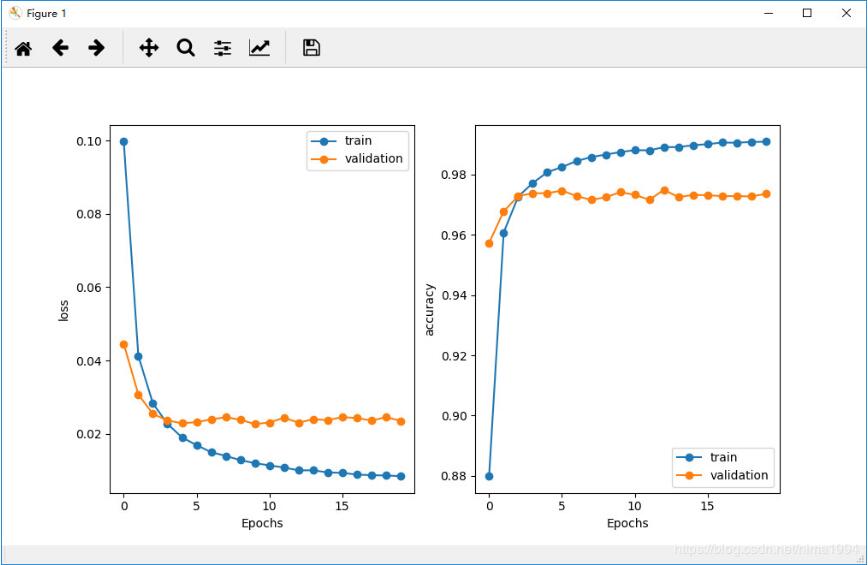代码位于keras的官方样例,并做了微量修改和大量学习?。
最终效果:


import keras
import numpy as np
import matplotlib.pyplot as plt
import random
from keras.callbacks import TensorBoard
from keras.datasets import mnist
from keras.models import Model
from keras.layers import Input, Flatten, Dense, Dropout, Lambda
from keras.optimizers import RMSprop
from keras import backend as K
num_classes = 10
epochs = 20
def euclidean_distance(vects):
x, y = vects
sum_square = K.sum(K.square(x - y), axis=1, keepdims=True)
return K.sqrt(K.maximum(sum_square, K.epsilon()))
def eucl_dist_output_shape(shapes):
shape1, shape2 = shapes
return (shape1[0], 1)
def contrastive_loss(y_true, y_pred):
'''Contrastive loss from Hadsell-et-al.'06
http://yann.lecun.com/exdb/publis/pdf/hadsell-chopra-lecun-06.pdf
'''
margin = 1
sqaure_pred = K.square(y_pred)
margin_square = K.square(K.maximum(margin - y_pred, 0))
return K.mean(y_true * sqaure_pred + (1 - y_true) * margin_square)
def create_pairs(x, digit_indices):
'''Positive and negative pair creation.
Alternates between positive and negative pairs.
'''
pairs = []
labels = []
n = min([len(digit_indices[d]) for d in range(num_classes)]) - 1
for d in range(num_classes):
for i in range(n):
z1, z2 = digit_indices[d][i], digit_indices[d][i + 1]
pairs += [[x[z1], x[z2]]]
inc = random.randrange(1, num_classes)
dn = (d + inc) % num_classes
z1, z2 = digit_indices[d][i], digit_indices[dn][i]
pairs += [[x[z1], x[z2]]]
labels += [1, 0]
return np.array(pairs), np.array(labels)
def create_base_network(input_shape):
'''Base network to be shared (eq. to feature extraction).
'''
input = Input(shape=input_shape)
x = Flatten()(input)
x = Dense(128, activation='relu')(x)
x = Dropout(0.1)(x)
x = Dense(128, activation='relu')(x)
x = Dropout(0.1)(x)
x = Dense(128, activation='relu')(x)
return Model(input, x)
def compute_accuracy(y_true, y_pred): # numpy上的操作
'''Compute classification accuracy with a fixed threshold on distances.
'''
pred = y_pred.ravel() < 0.5
return np.mean(pred == y_true)
def accuracy(y_true, y_pred): # Tensor上的操作
'''Compute classification accuracy with a fixed threshold on distances.
'''
return K.mean(K.equal(y_true, K.cast(y_pred < 0.5, y_true.dtype)))
def plot_train_history(history, train_metrics, val_metrics):
plt.plot(history.history.get(train_metrics), '-o')
plt.plot(history.history.get(val_metrics), '-o')
plt.ylabel(train_metrics)
plt.xlabel('Epochs')
plt.legend(['train', 'validation'])
# the data, split between train and test sets
(x_train, y_train), (x_test, y_test) = mnist.load_data()
x_train = x_train.astype('float32')
x_test = x_test.astype('float32')
x_train /= 255
x_test /= 255
input_shape = x_train.shape[1:]
# create training+test positive and negative pairs
digit_indices = [np.where(y_train == i)[0] for i in range(num_classes)]
tr_pairs, tr_y = create_pairs(x_train, digit_indices)
digit_indices = [np.where(y_test == i)[0] for i in range(num_classes)]
te_pairs, te_y = create_pairs(x_test, digit_indices)
# network definition
base_network = create_base_network(input_shape)
input_a = Input(shape=input_shape)
input_b = Input(shape=input_shape)
# because we re-use the same instance `base_network`,
# the weights of the network
# will be shared across the two branches
processed_a = base_network(input_a)
processed_b = base_network(input_b)
distance = Lambda(euclidean_distance,
output_shape=eucl_dist_output_shape)([processed_a, processed_b])
model = Model([input_a, input_b], distance)
keras.utils.plot_model(model,"siamModel.png",show_shapes=True)
model.summary()
# train
rms = RMSprop()
model.compile(loss=contrastive_loss, optimizer=rms, metrics=[accuracy])
history=model.fit([tr_pairs[:, 0], tr_pairs[:, 1]], tr_y,
batch_size=128,
epochs=epochs,verbose=2,
validation_data=([te_pairs[:, 0], te_pairs[:, 1]], te_y))
plt.figure(figsize=(8, 4))
plt.subplot(1, 2, 1)
plot_train_history(history, 'loss', 'val_loss')
plt.subplot(1, 2, 2)
plot_train_history(history, 'accuracy', 'val_accuracy')
plt.show()
# compute final accuracy on training and test sets
y_pred = model.predict([tr_pairs[:, 0], tr_pairs[:, 1]])
tr_acc = compute_accuracy(tr_y, y_pred)
y_pred = model.predict([te_pairs[:, 0], te_pairs[:, 1]])
te_acc = compute_accuracy(te_y, y_pred)
print('* Accuracy on training set: %0.2f%%' % (100 * tr_acc))
print('* Accuracy on test set: %0.2f%%' % (100 * te_acc))
以上这篇keras的siamese(孪生网络)实现案例就是小编分享给大家的全部内容了,希望能给大家一个参考,也希望大家多多支持自学编程网。

- 本文固定链接: https://zxbcw.cn/post/188577/
- 转载请注明:必须在正文中标注并保留原文链接
- QQ群: PHP高手阵营官方总群(344148542)
- QQ群: Yii2.0开发(304864863)
